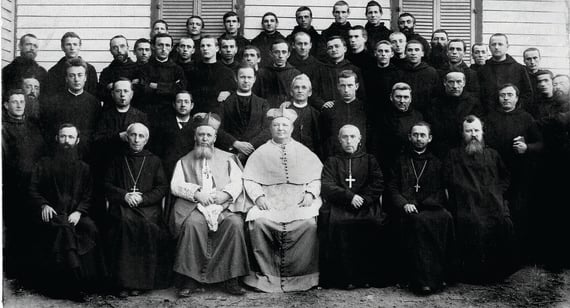-
 August 26, 2025Sesquicentennial: first of two
August 26, 2025Sesquicentennial: first of two
This is the first of two stories leading up to the October celebration of the sesquicentennial – 150 years – of the Catholic Church in Oklahoma.
On an October day in 1875, two intrepid monks from the French Benedictine monastery of Our Lady of La Pierre-qui-Vire set foot for the first time in the mission territory that had been entrusted to them by the Church.
The date was Oct. 12, and Father Isidore Robot, O.S.B., and Brother Dominic Lambert, O.S.B., finally arrived at a destiny and mission that was long in the making – a destiny and mission that would evolve into Saint Gregory’s Abbey, the Archdiocese of Oklahoma City and the Diocese of Tulsa.
“Oct. 12, 1875, is a shared beginning for Catholic life in Oklahoma,” said Abbot Lawrence Stasyszen, O.S.B. “We are grateful that Archbishop Paul Coakley of Oklahoma City and Bishop David Konderla of Tulsa are joining the monks of Saint Gregory’s to celebrate this important milestone in the life of the Church here.”
A number of events are planned in the months ahead, beginning in October 2025 and continuing through June 2027. The monastic community will observe the actual date of the arrival of the founding monks on Sunday, Oct. 12. The celebration will begin with Mass at 10 a.m. in the Abbey Church. Most Reverend Jonathan Licari, O.S.B., abbot president of the American Cassinese Congregation of Monasteries, will preside the Mass and will be joined by numerous other Benedictine abbots, representatives of other monasteries, Oblates and friends of Saint Gregory’s Abbey.
A Solemn Mass will then be celebrated at 4 p.m. Monday, Oct. 13 at the Blessed Stanley Rother Shrine. His Eminence Christophe Cardinal Pierre, Papal Nuncio to the United States, is scheduled to preside at the Mass with Archbishop Coakley, Bishop Konderla and Abbot Lawrence serving as principal concelebrants.
A history of God’s providential love
A particular set of historic, political and ecclesial circumstances came together in the establishment of the Catholic Church in what was at the time was Indian Territory.
The desire and request for the sacramental life of the Church came from Native American People who had been forcibly removed from their ancestral lands to land that the U.S. government had set aside as their new homeland. A good number of these Indian people were faithful Catholics, especially among the Potawatomi and Osage nations.
They desired the sacraments and hoped that their children might also have access to Catholic education and schools. Unfortunately, the missionary priests who had ministered to them were not able to accompany them to their new home, and there was no established jurisdiction of the Church to meet their needs.
Father Isidore and Brother Dominic had come to the United States from France to establish a monastery with missionary vision. First arriving in New Orleans, Bishop Napoleon Perche did not have a role for him in his diocese. As they looked for another location they heard from Father Maurice Gailland, S.J., a Jesuit missionary serving among the Potawatomi in Kansas. In a letter he urged the Benedictines to consider ministering to the “abandoned Indians, especially the Potawatomi.”
While visiting Paris, Bishop Perche encountered the head of Catholic Foreign Missions, Father Bernard Moreau. Having first rejected the monks when he met them in New Orleans, he now recommended that Indian Territory be established as a prefecture and be entrusted to the care of the two Benedictines who were looking for a home. This is what happened.
No longer responsible for a vast territory that had been under his care, Bishop Edward Fitzgerald of Little Rock summoned Father Isidore and Brother Dominic to give them the news that they now were entrusted with the mission of “Western Arkansas,” more formally known as Indian Territory.
Father Isidore and Brother Dominic arrived at Atoka, Indian Territory, on Oct. 12, 1875, where they found the only Catholic church built in the territory. Saint Patrick Catholic Church and rectory were not fully constructed and there was a $300 debt to pay. From that base, they made four excursions around Indian Territory to find the best location for their monastery.
They traveled more than 1,100 miles, visiting Catholics among the Citizen Potawatomi, Osage, Muscogee/Creek, Sac and Fox, Choctaw, Chickasaw, and tribes being confined to reservations around Fort Sill.
In the end, they decided to accept a generous offer from Chief Peter Pomaketak of the Citizen Potawatomi in the central part of the territory. The largely Catholic and French-speaking Citizen Potawatomi Nation thus became instrumental in the establishment of the Catholic Church in what now is Oklahoma.
They would be joined by other monks from France, and later, by the Religious Sisters of Mercy who first came to Sacred Heart, Benedictine Sisters who established their Motherhouse in Guthrie, and Franciscan Sisters who eventually served at Saint Patrick Indian Mission in Anadarko.
All of these dedicated religious sisters were indispensable partners in ministry throughout the territory. Together, they built schools and missions – nurtured by hospitality, hard work, Divine Providence and the faithfulness of the people who made up Catholic communities then – as now.
What began in rejection, has flourished by the grace of God.
For details on the Sesquicentennial observances, visit monksok.org for more information.
Photo: Bishop Meershaert at Sacred Heart Abbey for the Blessing of Abbot Thomas Duperou, O.S.B., Nov. 11, 1896. Photo St. Gregory’s Abbey archives.
